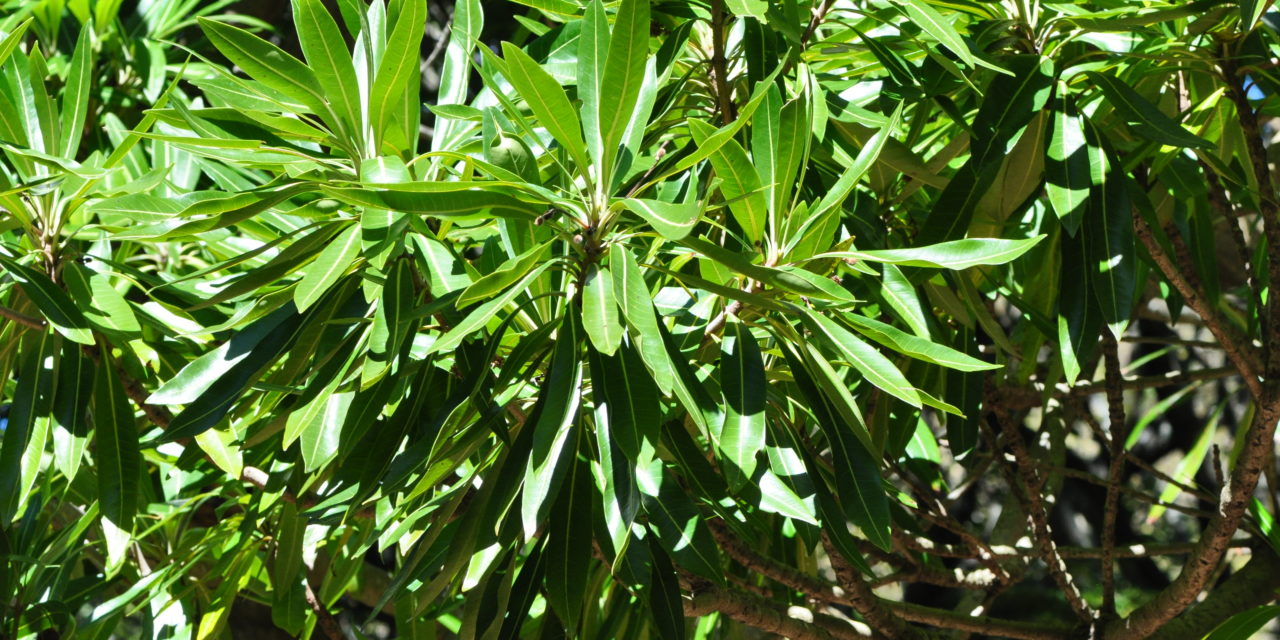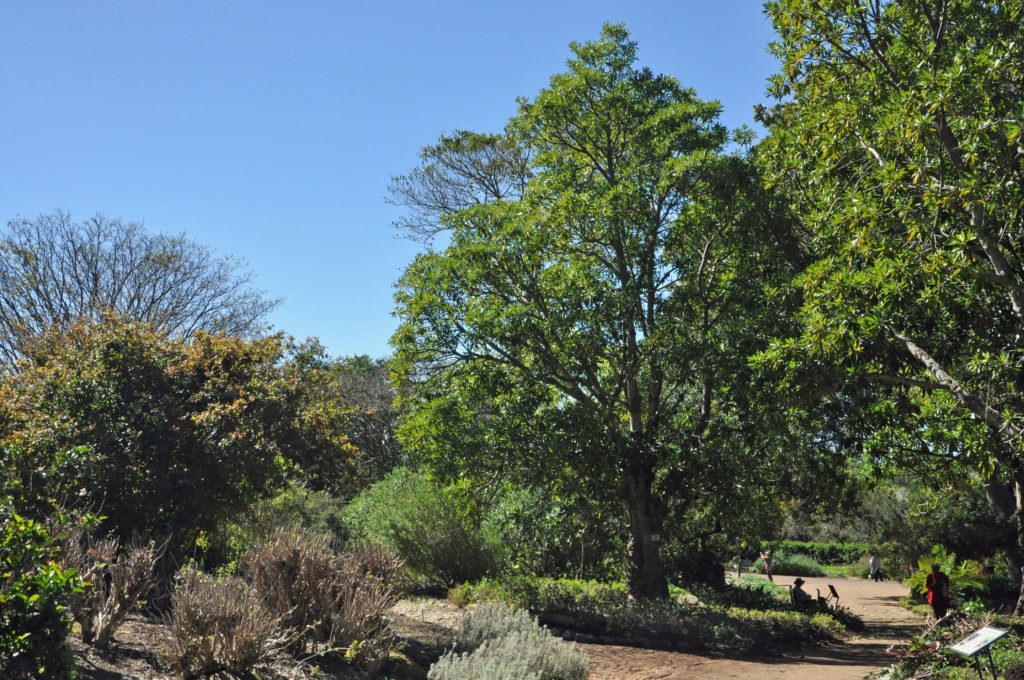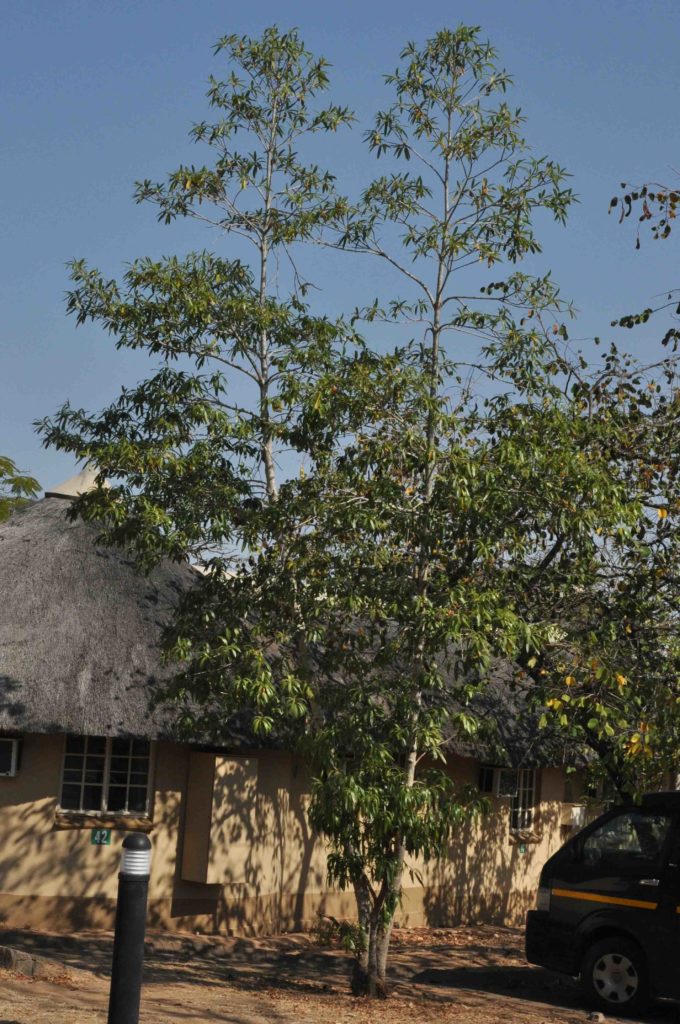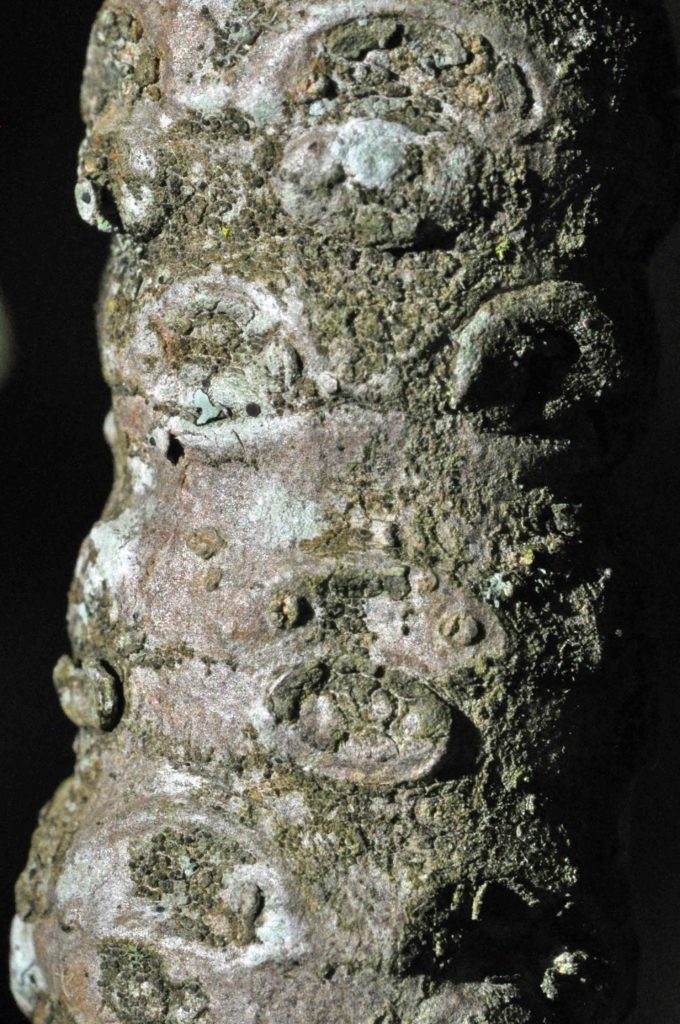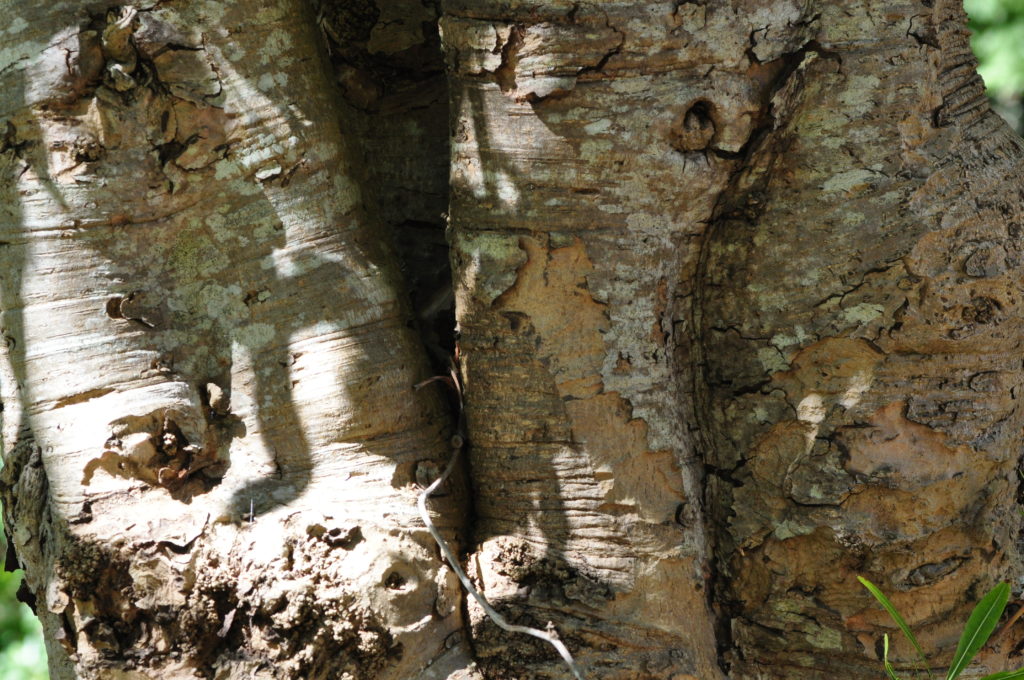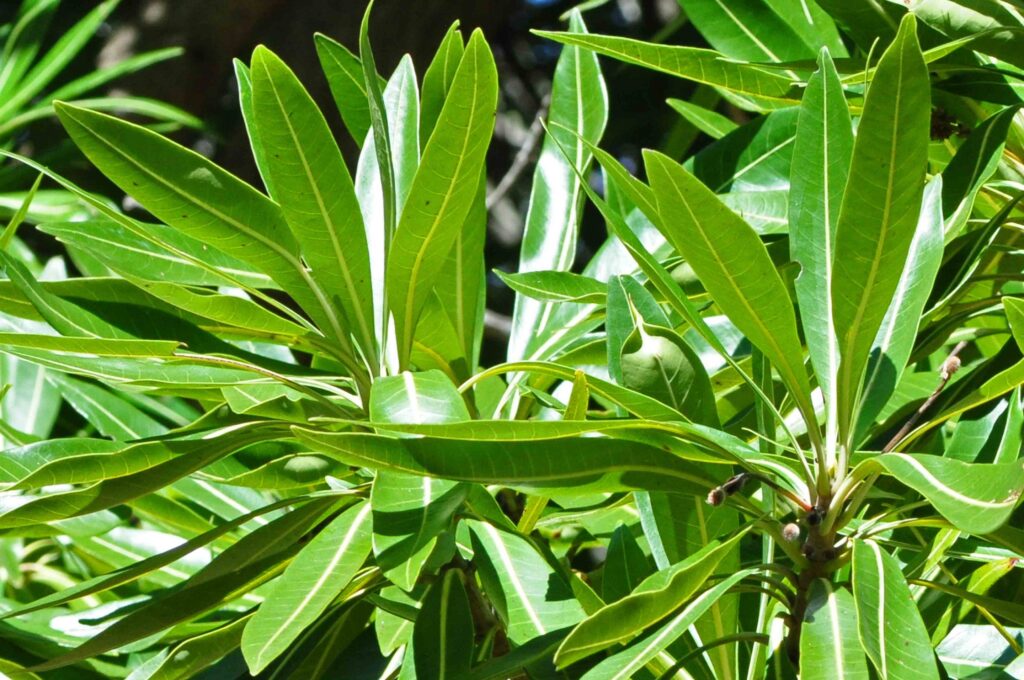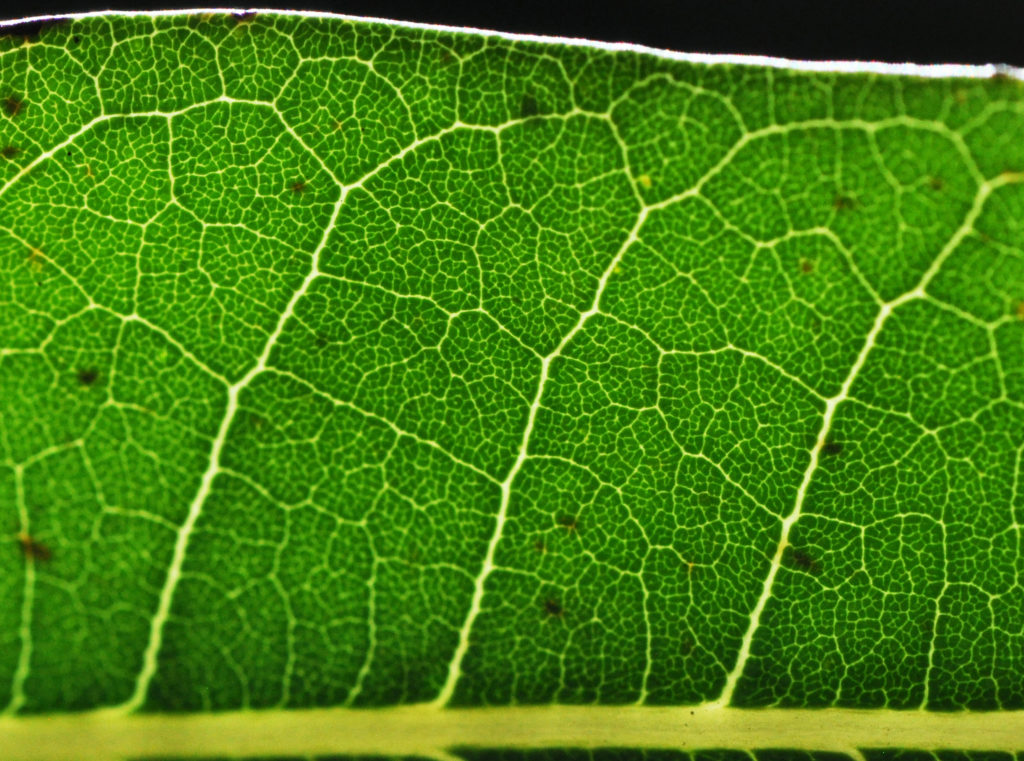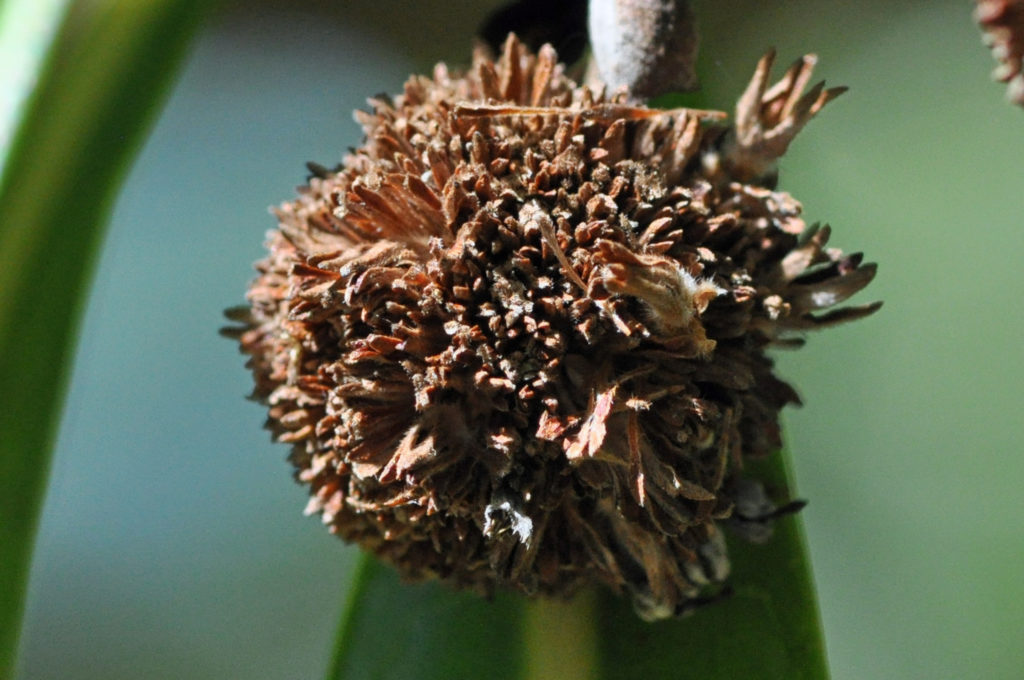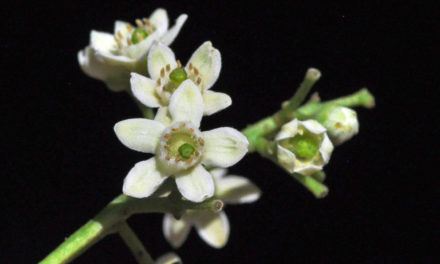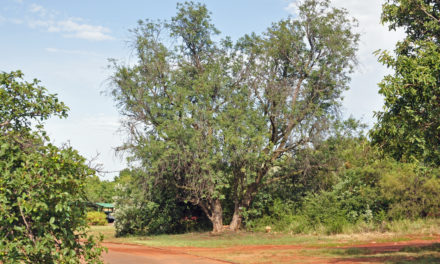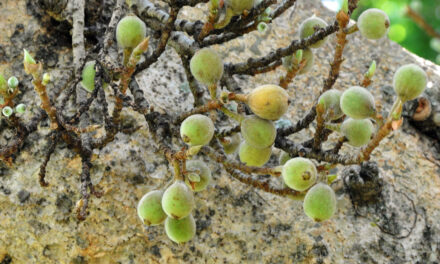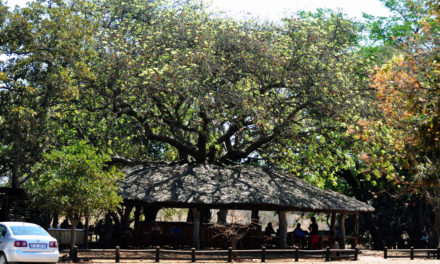General Info – summary
This deciduous Tree to 40m high and trunk diameter up to 1,5m. Wood is useable. Simple, entire hairless and leathery Leaves are in whorls. The whitish, bisexual, 5-merous Flowers are in compact spherical heads. Calyx and corolla are hairy. Filaments are shorter than basifixed anthers. The inferior ovary has an exerted style with an attached pollen presenter. Fruit is a capsule with small, wind-dispersed seeds.
Description
Breonadia salicina
Previous Names: Adina galpinii, Adina lasiantha, Adina microcephala, Adina microcephala var. galpinii, Breonadia microcephala, Cephalanthus spathelliferus, Nauclea microcephala.
SA Tree No. 684.
Common names: (Afr) Mingerhout, Waterboekenhout, Watermatoemie. (Eng) African Teak, Basterkiaat, Mingerhout, Matomi, Matumi, Transvaal Teak, Wild Oleander. (isiZulu) Umfomfo, Umfula, Umhlume. (Northern Sotho) Mohlome. (siSwati) Umhlume, Thlume. (Tshivenda) Mutulume. (Xitsonga) Mhlume.
Family: Rubiaceae (Coffee family). This family of dicotyledonous plants has in excess of 600 genera and about 13 000 species and members include trees, shrubs and herbs. Local genera with trees on this website include Afrocanthium, Canthium, Coddia, Gardenia, Pavetta, Rothmannia and Vangueria. Leaves are simple, opposite or whorled and have interpetiolar stipules. Flowers are bisexual or unisexual. The calyx has sepals that are at least partly united. Petals are joined – at least at the base. Stamens are usually as many as and alternating with corolla lobes. The Ovary is inferior. Fruit is a drupe, berry or capsule.
Family: Rubiaceae. (Coffee family). This family of dicotyledonous plants has in excess of 600 genera and about 13 000 species and members include trees, shrubs and herbs. Local genera with trees on this website include Afrocanthium, Canthium, Coddia, Gardenia, Pavetta, Rothmannia and Vangueria. Leaves are simple, opposite or whorled and have interpetiolar stipules. Flowers are bisexual or unisexual. The calyx has sepals that are at least partly united. Petals are joined – at least at the base. Stamens are usually as many as and alternating with corolla lobes. The Ovary is inferior. Fruit is a drupe, berry or capsule.
Name derivation: Breonadia was probably named after Jean Nicolas Breon (1815-1894) who collected plants in Mauritius. salicina – willow (Salix) like, possibly referring to the leaves.
Conservation: National Status: L C (Least Concern). Assessment: 2018 (L. von Staden).
Tree
This often-narrow crowned, tall timber Tree (photo 263) is up to 40m high and has a crown containing evergreen leaves. The sturdy, tall, straight Trunk may reach 1,5m wide and the initially smooth brown to grey-brown Bark (photo 231) becomes rough and flakes into irregular plates. Small branches are hairless. Here recently fallen leaves leave leaf scars (photo 216). No milky latex is present.
- 223 2018.09.11 Kirstenbosch NBG. Photo: David Becking.
- 263 2019.08.14 Pretoriuskop KNP. Photo: David Becking.
- 216 2018.09.11 Kirstenbosch NBG. Photo: David Becking.
- 231 2018.09.11 Kirstenbosch NBG. Photo: David Becking.
Leaves
The hairless, deciduous Leaves are graceful and simple (have a single blade which may have incisions that are not deep enough to divide the leaf into leaflets). They are usually arranged in whorls of 4 but may have 3 or 5 leaves (photo 222). Leaves are tough, leathery and tend to be concentrated towards the ends of branches. Individual leaves may reach 29 x 9cm. They are lanceolate to narrowly elliptic (photo 214) and are similar to leaves of Oleander. The Apex tapers to a pointed end. The Base tapers more sharply. The Blade is glossy, dark green above and lighter below (photo 214). Midrib (the main rib of a leaf or leaf-like part, a continuation of the petiole) is raised on both sides and veins are pale yellowish green. Lateral veins slope slightly upwards or run outwards at close to 90 degrees and loop together before reaching the margin. The small details of the leaf are best seen when viewed against a strong light (photo 218). The Margins are rolled under and entire (with a continuous margin, not in any way indented (photo 214). The Petiole (leaf stalk) is thickset (photo 222), may reach 2cm long and is partially decurrent (leaf blades that partly wrap or have wings around the stem or petiole – photo 222). The small, pointed Stipules (basal appendage of the petiole) occur between pairs of petioles.
- 222 2018.09.11 Kirstenbosch NBG. Photo: David Becking.
- 214 2018.09.11 Kirstenbosch NBG. Photo: David Becking.
- 218 2018.09.11 Kirstenbosch NBG. Photo: David Becking. Leaf against the sun.
Flowers
The very small (up to 4mm long), sweetly scented and bisexual Flowers occur in dense spherical heads with each of the many flowers subtended by a linear-spatulate Bract (usually a much-reduced specialised leaf). Each flower rests on a pedicel (stalk of a single flower). These spherical heads each rest on a thin peduncle (stalk of flower cluster) that is up to 9cm long with 2 connate bracts present. The oblong, 5-lobed Calyx is densely hairy. The hairy, tubular Corolla may be pinkish green, white, or yellowish brown. The 5 lobes are oblong and imbricate (having regularly arranged, overlapping edges, as roof tiles). Each of the 5 Stamens arise from the corolla throat. The linear Filaments are shorter than the basifixed Anthers, which end abruptly in a short, sharp arrowhead like point. The inferior Ovary has 2 locules (compartments) each containing several ovules. The club shaped Pollen Presenter rests on an exserted Style. Although situated on the tip of the style, the function of the pollen presenter is to aid cross-fertilization. Most avoid self-pollination by dispersing the pollen first – while the stigma is still covered). (Nov-Mar).
Fruit
The Fruit is a tiny 2-lobed Capsule (a dry fruit resulting from the maturing of a compound ovary, which usually opens at maturity by one or more lines of dehiscence between the carpels) and persistent calyx lobes are present. Many fruits develop together in hard, brown spherical flower heads (photo 220). The small, compressed Seeds are wind dispersed.
- 220 2018.09.11 Kirstenbosch NBG. Photo: David Becking.
Distribution & Ecology
This tropical species occurs in northern KwaZulu-Natal, Mpumalanga and Limpopo. Here it is widespread but not densely concentrated. Beyond the South Africa, it occurs in Madagascar, Swaziland, and northern central and extreme southern Mozambique. From here, it occurs northwards to Angola and into tropical Africa. It is common along permanent riverbanks and in riverine-fringed forests up to an altitude of 2 000m. Yellow beaked Rameron pigeons consume the Fruit and aid with seed dispersal. Game browse the Leaves. This is now a protected tree.
Ethnobotany
The moderately dense Wood is hard, fine-grained, durable and termite resistant. Cut wood is yellow to light brown. It has an oily smell and is resistant to termites. It varies from yellow to brown and has black or flame-like markings. Good furniture is made from it but it may be difficult to polish. Wood is used to construct canoes, huts and cattle-kraals. Local medicine makes use of the Bark, which is also rich in tannins. The plant Grows well from seeds but has invasive roots. Keep plants away from buildings and swimming pools. The tree is frost sensitive and should be Planted in moist, well drained soils. Seedlings are tender to both drought and frost.
References
Boon, R. 2010. Pooley’s Trees of eastern South Africa. Flora and Fauna Publications Trust, Durban.
Burrows, J.E., Burrows, S.M., Lotter, M.C. & Schmidt, E. 2018. Trees and Shrubs Mozambique. Publishing Print Matters (Pty) Ltd. Noordhoek, Cape Town.
Coates Palgrave, M. 2002. Keith Coates Palgrave Trees of Southern Africa, edn 3. Struik, Cape Town.
Ginn, P. J, McIlleron, W.G, & Mimstein, P. le S. 1991. The Complete Book of South African Birds. Struik, Cape Town/Singapore.
Lawrence, G. H. M, 1951. Taxonomy of Vascular Plants. The Macmillan Company, New York. Tenth Printing 1965.
Palmer, E. & Pitman, N. 1972. Trees of southern Africa. Balkema, Amsterdam, Cape Town.
Schmidt, S. Lotter, M. & McCleland, W. 2002. Trees and Shrubs of Mpumalanga and the Kruger National Park. Jacana, Johannesburg.
von Staden, L. 2018. Breonadia salicina (Vahl) Hepper & J.R.I.Wood. National Assessment: Red List of South African Plants version 2020.1. Accessed on 2022/10/24.
http://pza.sanbi.org/breonadia-salicina
http://home.intekom.com/ecotravel/plant-kingdom/trees/breonadia-salicina-matumi-mingerhout.htm
https://en.wikipedia.org/wiki/Rubiaceae

